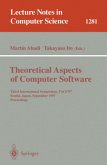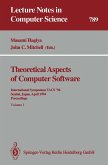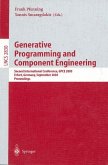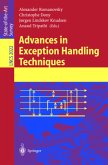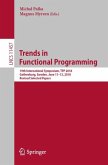The pattern calculus is a new foundation for computation, in which the expressive power of functions and of data structures are combined within pattern-matching functions. The best existing foundations focus on either functions, as in the lambda-calculus, or on data structures, as in Turing machines, or on compromises involving both, as in object-orientation. By contrast, a small typed pattern calculus is able to support all the main programming styles, including functional, imperative, object-oriented and query-based styles, and there is evidence that it can support a language for Web services, able to exploit data structures about which almost nothing is known.
The book is divided into three parts, on terms, types and programs, and contains many new results. Part I introduces static and then dynamic pattern calculus. The former supports path polymorphic functions, able to traverse arbitrary paths through data structures. It also shows how Lisp is more than just lambda-calculus. The dynamic calculus allows any term to be a pattern, so that patterns can be discovered, combined and simplified on the fly. Part II supports a family of type systems for pattern calculi that build on novel typings of lambda-calculus. The type system for query calculus allows database queries to be applied uniformly to arbitrary data structures, while still guaranteeing that evaluation terminates. Subtyping and type parameters combine to produce type inequalities, whose solutions provide an expressive account of object-orientation. Also, typing can be made implicit, which simplifies implementation. Part III realises all these ideas in a new programming language, bondi, where the various programming styles can be combined, including algebraic data types and object-oriented classes.
This book is useful for researchers with an interest in the foundations of computing, programming language design, the integration of existing programming styles, or the development of new programming styles. The reader is supported throughout with proofs and examples, both in text and in bondi, the source code of which is freely available online.
Over time, basic research tends to lead to specialization - increasingly narrow t- ics are addressed by increasingly focussed communities, publishing in increasingly con ned workshops and conferences, discussing increasingly incremental contri- tions. Already the community of programming languages is split into various s- communities addressing different aspects and paradigms (functional, imperative, relational, and object-oriented). Only a few people manage to maintain a broader view, and even fewer step back in order to gain an understanding about the basic principles, their interrelation, and their impact in a larger context. The pattern calculus is the result of a profound re-examination of a 50-year - velopment. It attempts to provide a unifying approach, bridging the gaps between different programming styles and paradigms according to a new slogan - compu- tion is pattern matching. It is the contribution of this book to systematically and elegantly present and evaluate the power of pattern matching as the guiding paradigm of programming. Patterns are dynamically generated, discovered, passed, applied, and automatically adapted, based on pattern matching and rewriting technology, which allows one to elegantly relate things as disparate as functions and data structures. Of course, pattern matching is not new. It underlies term rewriting - it is, for example, inc- porated in, typically functional, programming languages, like Standard ML - but it has never been pursued as the basis of a unifying framework for programming.
The book is divided into three parts, on terms, types and programs, and contains many new results. Part I introduces static and then dynamic pattern calculus. The former supports path polymorphic functions, able to traverse arbitrary paths through data structures. It also shows how Lisp is more than just lambda-calculus. The dynamic calculus allows any term to be a pattern, so that patterns can be discovered, combined and simplified on the fly. Part II supports a family of type systems for pattern calculi that build on novel typings of lambda-calculus. The type system for query calculus allows database queries to be applied uniformly to arbitrary data structures, while still guaranteeing that evaluation terminates. Subtyping and type parameters combine to produce type inequalities, whose solutions provide an expressive account of object-orientation. Also, typing can be made implicit, which simplifies implementation. Part III realises all these ideas in a new programming language, bondi, where the various programming styles can be combined, including algebraic data types and object-oriented classes.
This book is useful for researchers with an interest in the foundations of computing, programming language design, the integration of existing programming styles, or the development of new programming styles. The reader is supported throughout with proofs and examples, both in text and in bondi, the source code of which is freely available online.
Over time, basic research tends to lead to specialization - increasingly narrow t- ics are addressed by increasingly focussed communities, publishing in increasingly con ned workshops and conferences, discussing increasingly incremental contri- tions. Already the community of programming languages is split into various s- communities addressing different aspects and paradigms (functional, imperative, relational, and object-oriented). Only a few people manage to maintain a broader view, and even fewer step back in order to gain an understanding about the basic principles, their interrelation, and their impact in a larger context. The pattern calculus is the result of a profound re-examination of a 50-year - velopment. It attempts to provide a unifying approach, bridging the gaps between different programming styles and paradigms according to a new slogan - compu- tion is pattern matching. It is the contribution of this book to systematically and elegantly present and evaluate the power of pattern matching as the guiding paradigm of programming. Patterns are dynamically generated, discovered, passed, applied, and automatically adapted, based on pattern matching and rewriting technology, which allows one to elegantly relate things as disparate as functions and data structures. Of course, pattern matching is not new. It underlies term rewriting - it is, for example, inc- porated in, typically functional, programming languages, like Standard ML - but it has never been pursued as the basis of a unifying framework for programming.
From the reviews:
"In this book the author will make you have second thoughts about the possibility and desirability of compiling away pattern matching ... It is amazing that the dynamic pattern calculus is syntactically almost as simple as the pure lambda-calculus, yet it is much more expressive." (Eugenio Moggi, University of Genoa)
"More than anyone else, he has systematically explored both the theory and practice of pattern matching. More importantly, the knowledge thus gained has been largely transcribed into this book. Carefully written, it concisely explains the concepts surrounding the integration of pattern matching into both the operational semantics and the type system of two programming paradigms--functional and object-oriented. ... The audience for this book is researchers in programming language design; for them, I highly recommend this book." (Jacques Carette, ACM Computing Reviews, January, 2010)
"This work brings a new perspective for a theory that would unify the driving forces behind the main sub-groups of programming languages ... . The book addresses final year undergraduates, graduates from a research-oriented master and a broader range of specialists, experts in fields related to the foundation of computation. ... the perspective exposed here can be of great use for specialists working in the design of programming languages or in the design of tools and Web services ... ." (Mirel Cosulschi, Zentralblatt MATH, Vol. 1215, 2011)
"In this book the author will make you have second thoughts about the possibility and desirability of compiling away pattern matching ... It is amazing that the dynamic pattern calculus is syntactically almost as simple as the pure lambda-calculus, yet it is much more expressive." (Eugenio Moggi, University of Genoa)
"More than anyone else, he has systematically explored both the theory and practice of pattern matching. More importantly, the knowledge thus gained has been largely transcribed into this book. Carefully written, it concisely explains the concepts surrounding the integration of pattern matching into both the operational semantics and the type system of two programming paradigms--functional and object-oriented. ... The audience for this book is researchers in programming language design; for them, I highly recommend this book." (Jacques Carette, ACM Computing Reviews, January, 2010)
"This work brings a new perspective for a theory that would unify the driving forces behind the main sub-groups of programming languages ... . The book addresses final year undergraduates, graduates from a research-oriented master and a broader range of specialists, experts in fields related to the foundation of computation. ... the perspective exposed here can be of great use for specialists working in the design of programming languages or in the design of tools and Web services ... ." (Mirel Cosulschi, Zentralblatt MATH, Vol. 1215, 2011)


